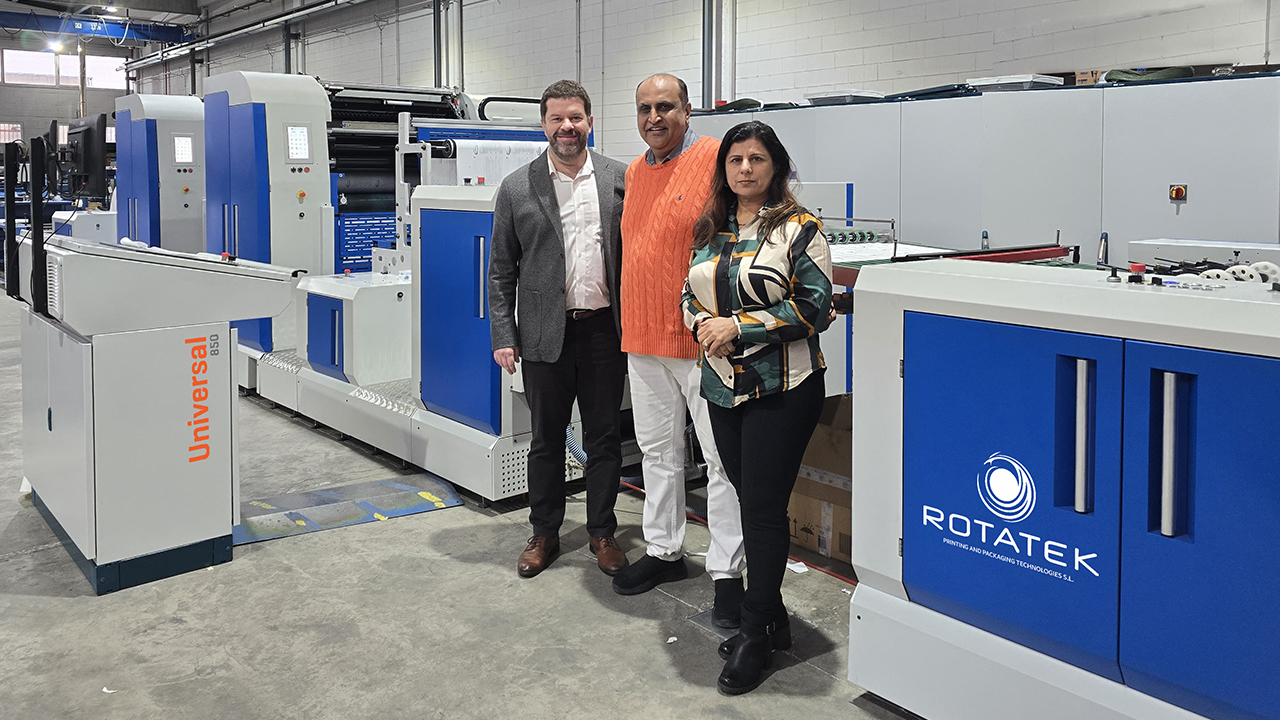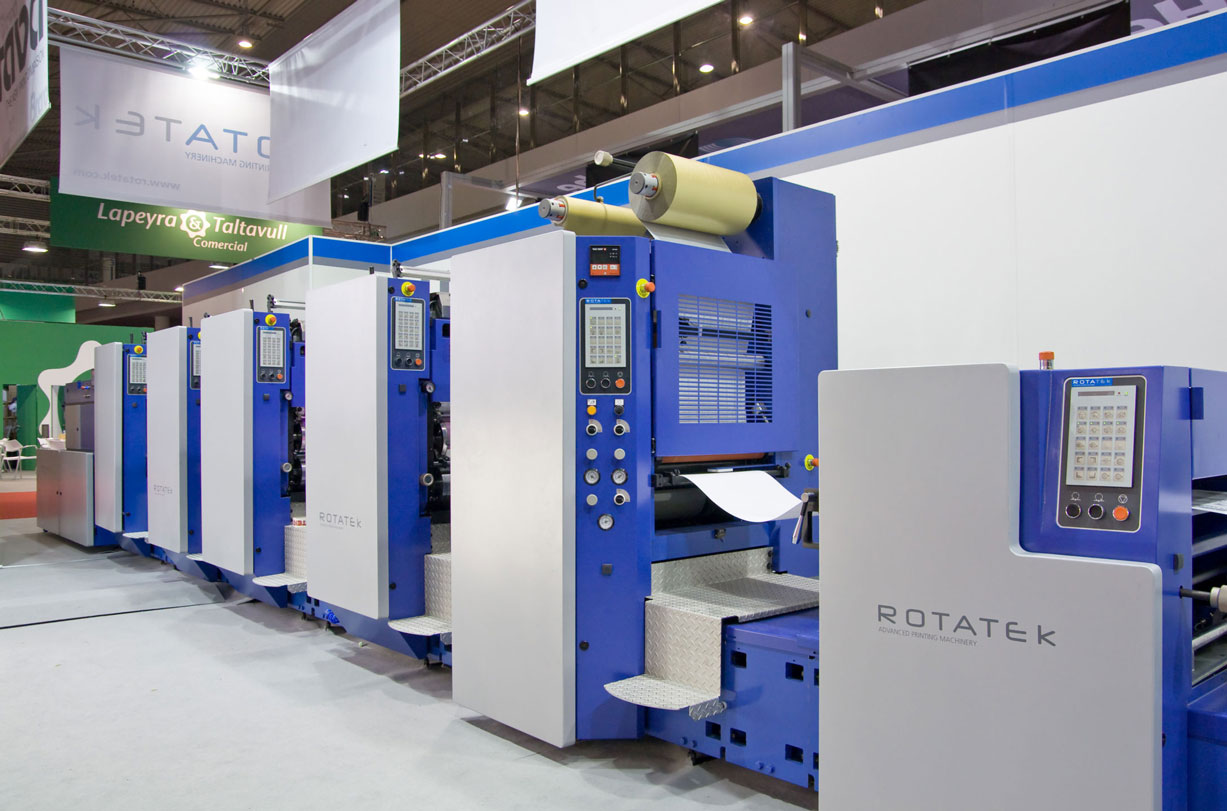Rotatek launches new press
Vinsak Group, the new owner of Rotatek, has major plans to develop rotary offset for the labels and package print industries.

L-R: Mario Gámez, Ranesh Bajaj and Dr Gita Bajaj, with redesigned Universal 850 press
Following the acquisition of Rotatek by India-based Vinsak Group two years ago, the rotary offset specialist is back with a fully redesigned Universal 850 and plans for both an offset-based hybrid press and a new version of the intermittent Brava press.
Rotatek Printing and Packaging Technologies will make its first exhibition appearance at Labelexpo Europe 2025 in Barcelona with a print unit from the Universal 850.
The Vinsak Group has a long history of association with Rotatek, having acted as the company’s sales and service agency in India, the Middle East and Africa. Vinsak maintains an extensive business servicing Rotatek presses globally, including new software updates.The Vinsak Group also handles sales and support of Lombardi UV flexo presses across India and MENA.
The Vinsak Group was founded by industry veteran Ranesh Bajaj in 1990. He was recently joined by Dr Gita Bajaj, who brings experience as a professor in business transformation and HR.
Rotatek was originally founded in 1970 and today boasts an installed base of 1,700 presses in more than 70 countries, with applications including leaflets and security printing, labels, flexible packaging and folding cartons.
Rotatek CEO Mario Gámez has an engineering background that includes managing dock installations across the UK ports industry.
Under Vinsak’s ownership, Rotatek has expanded its workforce, which now stands at 34 full-time and five contractual workers. Gita Bajaj and Mario Gámez have been busy recruiting electronic and software engineers, and are committed to training talented young people from the local area. Plans are underway to acquire a site to build a new production plant.

Rotary offset reboot
Although rotary offset has always been a core technology in high-end label production, it has been somewhat eclipsed by the increasing quality of UV flexography. But Ranesh Bajaj is a firm believer in the future of rotary offset in the package printing market and wants Rotatek to lead that development.
‘Rotatek clearly believes that offset is still a relevant technology in the labels and packaging market, and we will be spending considerable efforts and resources in the coming months to offer some game-changing technologies to our customers,’ says Bajaj. ‘Our focus is on new machines.’
The first machine brought to market by Vinsak-owned Rotatek is the sleeve-based Universal 850. Originally launched in 2008, the press was completely redesigned during the Covid pandemic, and the first units are now being shipped.
“Rotatek clearly believes that offset is still a relevant technology in the labels and packaging market, and we will be spending considerable efforts and resources to offer some game-changing technologies to our customers”
The key development is using lightweight sleeves with integral bearers and a pneumatic locking system that allows rapid change between job formats and ensures maximum stability during the print run.
Repeat size ranges from 20-40in (508-1016mm), allowing the larger formats found in IML, shrink sleeves and folding cartons to be handled.
After a sleeve change, the blanket and impression cylinders and the inking/forme and dampening roller assemblies are moved into position using 21 Individual servo motors per print unit. ‘This means make-ready operations are more automatic, accurate and repeatable,’ says Gámez. ‘We are able to change between jobs in two minutes.’
Other automation features on the Universal 850 include automatic register control and CIP4 ink key control, using a spectrophotometer for closed loop on-the-fly color adjustment.
The offset roller train has been completely redesigned and now includes a fourth ink forme roller. The oscillating ink roller system allows for adjustment tailored to different ink types, including UV and LED-UV. Technotrans supplies the ink temperature control system to ensure stable ink viscosity.
Rotatek is working on a new system to predict and automate ink-water balance.
‘We are doing studies with two of our automation partners to deploy AI-based models for the presses to be able to predict the behavior of ink-water balance on presses when changing press speeds, substrates and pressroom conditions during the day,’ says Bajaj. ‘We have seen some very encouraging results in being able to reduce the waste drastically and reduce setup times. This could soon be a game changer in the offset industry.’
The Universal 850 prints at up to 400m/min roll-to-roll and 300m/min roll-to-sheet. Maximum substrate width is 870mm, and maximum print width 850mm. Substrate range is between 12-80 microns for fi lms, 30-400gsm for paper, and 150-400gsm for folding cartons, opening up a wide range of possible applications.
When L&L visited the Barcelona production plant, a two-unit Universal 850 with turnbar and sheeter was about to be shipped to a company in France for printing pharma leaflets. A second press configured for in-mold labels with seven offset and two flexo units is under construction. Rotatek is working with Schober and other IML finishing technologies to accompany the press.
For folding carton applications, Rotatek is currently working on a waste eject system with its rotary die-cutting partners. In this configuration, there are separate die stations for creasing and cutting.
“We are doing studies on how to deploy AI-based models to predict the behavior of ink-water balance on presses when changing press speeds, substrates and pressroom conditions”
Rotatek also looks at in-line wet glue label production on the Universal 850. A prototype system is currently under development. ‘With a format size of 850mm x 1 meter repeat, we are the same size as a sheet-fed machine and we can print at 300m/min, which is equivalent to 18,000 sheets/hour,’ says Gámez. ‘This matches our philosophy of producing finished products in one process, including in-mold labels, carton boxes and wet glue labels.’
New Brava and hybrid
A strong part of Rotatek’s heritage was its ground-breaking Brava intermittent offset press. Launched in 2004, the Brava could be switched between intermittent and full rotary modes. Users in the labels industry include Marzek Etiketten (see Labels & Labeling Issue 1).
Rotatek is now working on a major redesign, with the new press scheduled for launch in early 2026. Gámez says this will be a ‘fully revamped Brava press that is more relevant to today’s needs of short-run label production.’
The press will be available in 450mm and 520mm versions. ‘We are not producing the 350mm press anymore, as we were not competitive at that width,’ says Gámez. The new Brava will not have the option to switch to full rotary mode. An update on the new press will be delivered at Labelexpo Europe 2025.
Rotatek is also developing a new hybrid press that combines semi-rotary offset with digital print and embellishment technology developed independently by the Vinsak Group.
Explains Ranesh Bajaj, ‘Combined with the technical and financial strength of the Vinsak group, we hope to build a new hybrid model of creating aesthetically appealing packaging economically and making it smart and connected with our VDP solutions. We believe this is the way forward for the industry.’
Another area for synergistic hybrid development between Vinsak and Rotatek is security printing.
Security has historically been a strong market for Rotatek, offering technologies such as intaglio printing.
Rotatek has worked closely with Pantec, Newmec and other vendors to apply holographic tax stamps in-line in up to 12 strips. The same technology is also available for decorative applications.
Vinsak has its own in-house security print design center for applications ranging from brand protection to security documents and builds its own specialist digital print and embellishment hardware.
States Bajaj, ‘Together, our security printing solutions now offer combination presses with dry and wet offset, flexo, rotary and flatbed hot foiling, die-cutting, monochrome or full color digital printing, all in-line to make the production of tax stamps, visas and similar products highly secure and counterfeit resistant.’
Ranesh Bajaj is excited by the future potential of the Rotatek-Vinsak collaboration.
He concludes, ‘Our wider range of presses from 520mm to 850mm already offers unique flexibility and higher productivity than most similar web presses currently available on the market. We are also employing considerable resources in revamping our product line in the coming 12-24 months to make our products even more efficient in producing labels, flexibles and folding cartons.’
ECG Debate
Extended color gamut printing — printing with seven colors permanently in the press – is a hot topic in the flexo industry today. Benefits include not having to wash print units down between jobs and the ability to hit multiple Pantones without requiring special colors.
Ranesh Bajaj is not convinced of the benefits of ECG in the rotary offset world.
‘ECG printing requires seven print units, but there is no good reason for a press to have more than five print units. For 20,000 euros, I can receive an automated ink mixing kitchen, which now has no waste as the colors can be reused. With ECG, you are always paying to keep seven colors in the press, even when you are not using them. The additional capital, power and labor needed for doing every single or 2- color job in seven colors is not fully justified.’
Stay up to date
Subscribe to the free Label News newsletter and receive the latest content every week. We'll never share your email address.


